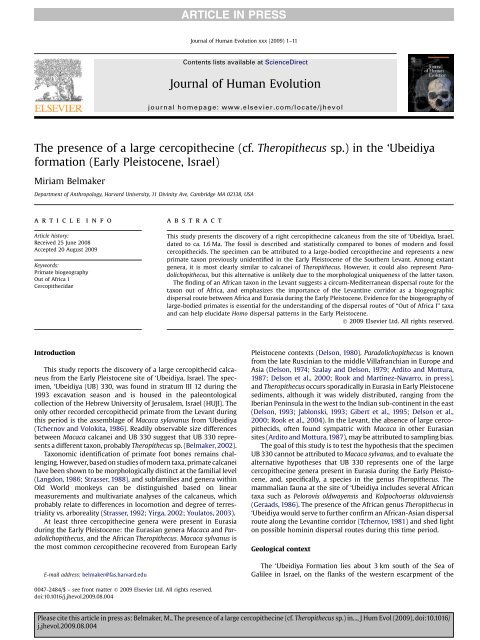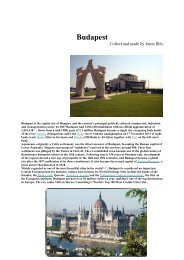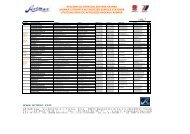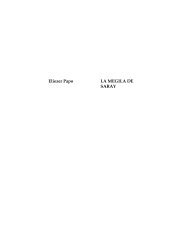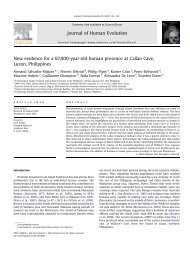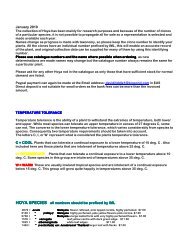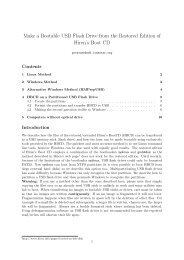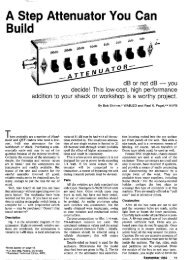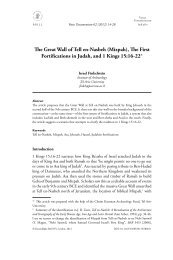ARTICLE IN PRESS Journal of Human Evolution
ARTICLE IN PRESS Journal of Human Evolution
ARTICLE IN PRESS Journal of Human Evolution
You also want an ePaper? Increase the reach of your titles
YUMPU automatically turns print PDFs into web optimized ePapers that Google loves.
The presence <strong>of</strong> a large cercopithecine (cf. Theropithecus sp.) in the ‘Ubeidiya<br />
formation (Early Pleistocene, Israel)<br />
Miriam Belmaker<br />
Department <strong>of</strong> Anthropology, Harvard University, 11 Divinity Ave, Cambridge MA 02138, USA<br />
article info<br />
Article history:<br />
Received 25 June 2008<br />
Accepted 20 August 2009<br />
Keywords:<br />
Primate biogeography<br />
Out <strong>of</strong> Africa I<br />
Cercopithecidae<br />
Introduction<br />
abstract<br />
This study reports the discovery <strong>of</strong> a large cercopithecid calcaneus<br />
from the Early Pleistocene site <strong>of</strong> ‘Ubeidiya, Israel. The specimen,<br />
‘Ubeidiya (UB) 330, was found in stratum III 12 during the<br />
1993 excavation season and is housed in the paleontological<br />
collection <strong>of</strong> the Hebrew University <strong>of</strong> Jerusalem, Israel (HUJI). The<br />
only other recorded cercopithecid primate from the Levant during<br />
this period is the assemblage <strong>of</strong> Macaca sylavanus from ‘Ubeidiya<br />
(Tchernov and Volokita, 1986). Readily observable size differences<br />
between Macaca calcanei and UB 330 suggest that UB 330 represents<br />
a different taxon, probably Theropithecus sp. (Belmaker, 2002).<br />
Taxonomic identification <strong>of</strong> primate foot bones remains challenging.<br />
However, based on studies <strong>of</strong> modern taxa, primate calcanei<br />
have been shown to be morphologically distinct at the familial level<br />
(Langdon, 1986; Strasser, 1988), and subfamilies and genera within<br />
Old World monkeys can be distinguished based on linear<br />
measurements and multivariate analyses <strong>of</strong> the calcaneus, which<br />
probably relate to differences in locomotion and degree <strong>of</strong> terrestriality<br />
vs. arboreality (Strasser, 1992; Yirga, 2002; Youlatos, 2003).<br />
At least three cercopithecine genera were present in Eurasia<br />
during the Early Pleistocene: the Eurasian genera Macaca and Paradolichopithecus,<br />
and the African Theropithecus. Macaca sylvanus is<br />
the most common cercopithecine recovered from European Early<br />
E-mail address: belmaker@fas.harvard.edu<br />
0047-2484/$ – see front matter Ó 2009 Elsevier Ltd. All rights reserved.<br />
doi:10.1016/j.jhevol.2009.08.004<br />
<strong>ARTICLE</strong> <strong>IN</strong> <strong>PRESS</strong><br />
<strong>Journal</strong> <strong>of</strong> <strong>Human</strong> <strong>Evolution</strong> xxx (2009) 1–11<br />
Contents lists available at ScienceDirect<br />
<strong>Journal</strong> <strong>of</strong> <strong>Human</strong> <strong>Evolution</strong><br />
journal homepage: www.elsevier.com/locate/jhevol<br />
This study presents the discovery <strong>of</strong> a right cercopithecine calcaneus from the site <strong>of</strong> ‘Ubeidiya, Israel,<br />
dated to ca. 1.6 Ma. The fossil is described and statistically compared to bones <strong>of</strong> modern and fossil<br />
cercopithecids. The specimen can be attributed to a large-bodied cercopithecine and represents a new<br />
primate taxon previously unidentified in the Early Pleistocene <strong>of</strong> the Southern Levant. Among extant<br />
genera, it is most clearly similar to calcanei <strong>of</strong> Theropithecus. However, it could also represent Paradolichopithecus,<br />
but this alternative is unlikely due to the morphological uniqueness <strong>of</strong> the latter taxon.<br />
The finding <strong>of</strong> an African taxon in the Levant suggests a circum-Mediterranean dispersal route for the<br />
taxon out <strong>of</strong> Africa, and emphasizes the importance <strong>of</strong> the Levantine corridor as a biogeographic<br />
dispersal route between Africa and Eurasia during the Early Pleistocene. Evidence for the biogeography <strong>of</strong><br />
large-bodied primates is essential for the understanding <strong>of</strong> the dispersal routes <strong>of</strong> ‘‘Out <strong>of</strong> Africa I’’ taxa<br />
and can help elucidate Homo dispersal patterns in the Early Pleistocene.<br />
Ó 2009 Elsevier Ltd. All rights reserved.<br />
Pleistocene contexts (Delson, 1980). Paradolichopithecus is known<br />
from the late Ruscinian to the middle Villafranchian in Europe and<br />
Asia (Delson, 1974; Szalay and Delson, 1979; Ardito and Mottura,<br />
1987; Delson et al., 2000; Rook and Martínez-Navarro, in press),<br />
and Theropithecus occurs sporadically in Eurasia in Early Pleistocene<br />
sediments, although it was widely distributed, ranging from the<br />
Iberian Peninsula in the west to the Indian sub-continent in the east<br />
(Delson, 1993; Jablonski, 1993; Gibert et al., 1995; Delson et al.,<br />
2000; Rook et al., 2004). In the Levant, the absence <strong>of</strong> large cercopithecids,<br />
<strong>of</strong>ten found sympatric with Macaca in other Eurasian<br />
sites (Ardito and Mottura,1987), may be attributed to sampling bias.<br />
The goal <strong>of</strong> this study is to test the hypothesis that the specimen<br />
UB 330 cannot be attributed to Macaca sylvanus, and to evaluate the<br />
alternative hypotheses that UB 330 represents one <strong>of</strong> the large<br />
cercopithecine genera present in Eurasia during the Early Pleistocene,<br />
and, specifically, a species in the genus Theropithecus. The<br />
mammalian fauna at the site <strong>of</strong> ‘Ubeidiya includes several African<br />
taxa such as Pelorovis oldwayensis and Kolpochoerus olduvaiensis<br />
(Geraads, 1986). The presence <strong>of</strong> the African genus Theropithecus in<br />
‘Ubeidiya would serve to further confirm an African-Asian dispersal<br />
route along the Levantine corridor (Tchernov, 1981) and shed light<br />
on possible hominin dispersal routes during this time period.<br />
Geological context<br />
The ‘Ubeidiya Formation lies about 3 km south <strong>of</strong> the Sea <strong>of</strong><br />
Galilee in Israel, on the flanks <strong>of</strong> the western escarpment <strong>of</strong> the<br />
Please cite this article in press as: Belmaker, M., The presence <strong>of</strong> a large cercopithecine (cf. Theropithecus sp.) in..., J Hum Evol (2009), doi:10.1016/<br />
j.jhevol.2009.08.004
2<br />
<strong>ARTICLE</strong> <strong>IN</strong> <strong>PRESS</strong><br />
Jordan Rift (Fig. 1). The archaeological layers <strong>of</strong> the ‘Ubeidiya<br />
Formation have been systematically excavated since 1960 (Stekelis,<br />
1966a,b; Stekelis et al., 1969; Bar-Yosef and Goren-Inbar, 1993)<br />
through the late 1990s (Stekelis,1966a; Stekelis et al.,1969; Bar-Yosef<br />
and Goren-Inbar, 1993; Guérin et al., 1996,2003; Shea and Bar-Yosef,<br />
1998), and are known for rich faunal (Haas, 1966,1968; Tchernov,<br />
1986; Belmaker, 2006) and lithic assemblages (Bar-Yosef and Goren-<br />
Inbar, 1993; Shea and Bar-Yosef, 1998). The primate assemblage<br />
includes dental and postcranial material <strong>of</strong> Macaca sylvanus (Tchernov<br />
and Volokita,1986) as well as a small sample <strong>of</strong> Homo cf. ergaster/<br />
erectus dental material (Tobias, 1966a,b; Belmaker et al., 2002).<br />
Estimated dates for the fossil-bearing strata <strong>of</strong> the ‘Ubeidiya<br />
Formation are between ca. 1.6–1.2 Ma. Paleomagnetic analysis <strong>of</strong><br />
the ‘Ubeidiya Formation indicate that it overlies the ‘Erq el Ahmar<br />
Formation, which is dated at 1.96–1.78 Ma (Ron and Levi, 2001) and<br />
has a reversed polarity, suggesting that it predates the Brunhes–<br />
Matuyama reversal (Opdyke et al., 1983; Braun et al., 1991; Verosub<br />
and Tchernov, 1991). Two short, normal paleomagnetic episodes<br />
M. Belmaker / <strong>Journal</strong> <strong>of</strong> <strong>Human</strong> <strong>Evolution</strong> xxx (2009) 1–11<br />
Figure 1. Location <strong>of</strong> the site <strong>of</strong> ‘Ubeidiya in the Southern Levant.<br />
have been found in strata II 33 and II 23–24 in the Fi member and<br />
have been assigned to the Cobb Mt. (1.215–1.190 Ma) and the Gilsa<br />
(1.575–1.567 Ma), respectively (Sagi, 2005). The dating <strong>of</strong> these<br />
short polarity events is corroborated by local faunal turnovers. The<br />
‘Ubeidiya fauna can be assigned to a local mammalian fauna biozone<br />
older than that in the sites <strong>of</strong> Bitzat Ruhama, Evron, and<br />
Latamne dated to ca. 1.0–1.2 Ma, suggesting that the ‘Ubeidiya<br />
normal polarity events in strata II 23-24 and II 33 should both<br />
predate the Jaramillo (0.99–1.07 Ma). (For a detailed stratigraphic<br />
correlation, see Supplementary Online Material Figure S1) (Belmaker,<br />
2009). Furthermore, the large mammalian assemblage <strong>of</strong><br />
‘Ubeidiya is similar to the Farneta faunal unit (the sites <strong>of</strong> Selvella<br />
and Pietrafitta, Italy) (Belmaker, 2006; Martínez-Navarro et al.,<br />
2009), which has been dated to ca. 1.6–1.2 Ma (Caloi and Palombo,<br />
1997, and references therein), and the lithic assemblage is similar to<br />
those from East African sites (Stekelis et al., 1969; Bar-Yosef and<br />
Goren-Inbar, 1993) such as Olduvai Upper Bed II, dated to ca. 1.53–<br />
1.27 Ma (Gowlett, 1979; Cerling and Hay, 1986).<br />
Please cite this article in press as: Belmaker, M., The presence <strong>of</strong> a large cercopithecine (cf. Theropithecus sp.) in..., J Hum Evol (2009), doi:10.1016/<br />
j.jhevol.2009.08.004
The total accumulation between the two normal episodes is ca.<br />
30 m. The micromorphological analysis <strong>of</strong> the paleolake ‘Ubeidiya<br />
delta system included periods <strong>of</strong> hiatus, probably in the range <strong>of</strong><br />
several thousands <strong>of</strong> years during which pedogenic processes<br />
occurred, suggesting that the estimated duration <strong>of</strong> 400 k.yr. is not<br />
inconsistent with the geomorphology <strong>of</strong> the site (Mallol, 2006).<br />
The specimen UB 330 described here was found in stratum III 12<br />
in the Li member. It is stratigraphically below the Fi member that<br />
contains the short, normal polarity events, indicating that it most<br />
probably predates the Gilsa (ca. 1.575 Ma). Thus, the estimated date<br />
for stratum III 12 and specimen UB 330 is ca.1.6–1.58 Ma (Figure S2).<br />
Materials and methods<br />
<strong>ARTICLE</strong> <strong>IN</strong> <strong>PRESS</strong><br />
Figure 2. UB 330, a right calcaneus. A: Medial view, B: Lateral view, C: Plantar (inferior) view, D: Dorsal (superior) view. The scale bar represents 5 cm.<br />
The fossil specimen UB 330 (Fig. 2) was compared to calcanei <strong>of</strong><br />
adult extant and fossil Cercopithecidae. Calcanei were measured<br />
from specimens <strong>of</strong> extant Cercopithecidae species from the American<br />
Museum <strong>of</strong> Natural History, the Museum <strong>of</strong> Comparative<br />
Zoology, as well as one specimen from the personal collection <strong>of</strong><br />
Philip Rightmire. Comparative fossil material included an unpublished<br />
Macaca sylvanus from ‘Ubeidiya (UB 101), as well as two casts<br />
<strong>of</strong> Theropithecus oswaldi (from Kanjera, Kenya), and a cast <strong>of</strong> Paracolobus<br />
chemeroni (Chemeron Fm., Kenya) generously provided by<br />
E. Delson. All extant comparative specimens (n ¼ 146) were adult,<br />
based on tooth eruption and fusion <strong>of</strong> limb elements (Table 1).<br />
Measurements were taken with digital calipers on both modern<br />
and fossil specimens to an accuracy <strong>of</strong> two decimal places (Fig. 3).<br />
Measurements followed Langdon (1986) and Yirga (2002). Analysis<br />
was performed on size-adjusted data. Two methods <strong>of</strong> size<br />
adjustments were used. First, raw variables were transformed to<br />
size-adjusted Mosimann shape data (Mosimann, 1970; Falsetti<br />
et al., 1993; Jungers et al., 1995). Each <strong>of</strong> the 14 raw measurements<br />
1<br />
The geometric mean is calculated as the nth root <strong>of</strong> the product <strong>of</strong> n<br />
measurements.<br />
M. Belmaker / <strong>Journal</strong> <strong>of</strong> <strong>Human</strong> <strong>Evolution</strong> xxx (2009) 1–11 3<br />
was divided by the geometric mean 1 , producing 14 size-adjusted<br />
ratio variables (designated by the variable name followed by the<br />
subscript ‘‘/GM,’’ e.g., Cal 1/GM). Second, 16 ratios were calculated<br />
following Langdon (1986), Strasser (1992), and Yirga (2002). Thus,<br />
a total <strong>of</strong> 30 variables (14 Mosimann shape-adjusted and 16 ratios)<br />
were used in this analysis (Tables S1 and S2).<br />
Size-adjusted values <strong>of</strong> UB 330 were compared to modern cercopithecid<br />
generic means using the single observation means t-test<br />
(Sokal and Rohlf, 1995). Multiple comparisons, such as the one<br />
performed here, require adjusting the probability values for the<br />
number <strong>of</strong> simultaneous tests to avoid Type I errors. To increase the<br />
power <strong>of</strong> the test, the sequential Bonferroni method was applied<br />
(Rice, 1989). A P value <strong>of</strong> 0.00033 was set as the test criterion <strong>of</strong> the<br />
single sample t-test.<br />
Discriminant Function Analysis (DFA) uses correlation metrics to<br />
address weight combinations <strong>of</strong> variables and emphasizes between<br />
group variation while minimizing within group variation. In this<br />
study, a two-tier stepwise Linear Discriminant Function was<br />
applied to the size-adjusted variables using stepwise insertion <strong>of</strong><br />
variables (maximizing the smallest F ratio) with UB 330 treated as<br />
a separate group (Sokal and Rohlf, 1995). First, a DFA was run at the<br />
subfamilial level to test the hypothesis that UB 330 could be<br />
identified as a member <strong>of</strong> Colobinae or Cercopithecinae. Second,<br />
a DFA was run at the generic level confined to cercopithecines<br />
(Cercopithecus, Macaca, Mandrillus, Papio, and Theropithecus).<br />
(Methodological considerations <strong>of</strong> the DFA are presented in the<br />
Supplementary Online Material.) Leave-one-out cross validation<br />
was used to assess the overall error rate for the DFA. Furthermore,<br />
bias and standard error around the predicted posterior probabilities<br />
for UB 330 were estimated using the jackknife procedure. This<br />
was performed by running the DFA while randomly removing<br />
a single observation at a time and iterated for the total number <strong>of</strong><br />
specimens (n ¼ 150).<br />
Linear regressions <strong>of</strong> cercopithecid indices <strong>of</strong> calcaneus pedal<br />
power arm (Cal 20) and calcaneal load arm (Cal 21) with body mass,<br />
have shown significant correlations at the 0.001 significance level<br />
Please cite this article in press as: Belmaker, M., The presence <strong>of</strong> a large cercopithecine (cf. Theropithecus sp.) in..., J Hum Evol (2009), doi:10.1016/<br />
j.jhevol.2009.08.004
4<br />
Table 1<br />
Comparative species measured by sex.<br />
Family Genus Species \ _ U Total<br />
Colobinae Colobus Colobus guereza 2 2 1 5<br />
Colobus polykomos 1 0 6 7<br />
Colobus sp. 0 0 1 1<br />
Procolobus Procolobus badius 2 1 1 4<br />
Paracolobus Paracolobus chemeroni 0 0 1 1<br />
Cercopithecinae Cercopithecus ascanius 1 3 0 4<br />
Cercopithecus diana 0 1 2 3<br />
Cercopithecus erythrotis 0 0 1 1<br />
Cercopithecus hamlyni 0 1 1 2<br />
Cercopithecus mitis 3 7 1 11<br />
Cercopithecus mona 0 2 0 2<br />
Cercopithecus nictitans 0 0 1 1<br />
Macaca Macaca arctoides 1 0 0 1<br />
Macaca assamensis 0 2 1 3<br />
Macaca fascicularis 18 19 0 37<br />
Macaca fuscata 0 3 0 3<br />
Macaca maura 0 1 0 1<br />
Macaca mulatta 0 3 0 3<br />
Macaca nemestrina 7 6 0 13<br />
Macaca nigra 0 0 1 1<br />
Macaca ochreata 1 0 0 1<br />
Macaca sp. 0 1 0 1<br />
Macaca sylvanus 2 0 2 4<br />
Macaca thibetana 0 1 0 1<br />
Macaca tonkeana 1 5 0 6<br />
Mandrillus Mandrillus leucophaeus 0 1 0 1<br />
Mandrillus sphinx 4 5 0 9<br />
Papio Papio hamadryas a<br />
2 16 0 18<br />
Theropithecus Theropithecus gelada 1 2 0 3<br />
Theropithecus oswaldi 0 0 2 2<br />
with R 2 above 0.9 (Strasser, 1992). Estimated body mass <strong>of</strong> UB 330,<br />
based on calcaneus body mass regression equations developed by<br />
Strasser (1992), were compared to Plio-Pleistocene fossil primate<br />
body mass estimates, as retrieved from the literature (Delson et al.,<br />
2000).<br />
All analyses were performed using SPSS (version 16.0) statistical<br />
s<strong>of</strong>tware. The jackknife DFA procedure was calculated using R.<br />
Taxonomic comparisons and statistical results<br />
Description<br />
<strong>ARTICLE</strong> <strong>IN</strong> <strong>PRESS</strong><br />
Total 150<br />
a Papio hamadryas includes individuals assigned to five subspecies: P. h. ursinus, P. h. hamadryas, P. h. anubis, P. h. cynocephalus, and P. h. papio.<br />
A complete right calcaneus, catalogue number ‘Ubeidiya (UB)<br />
330, was found in stratum III 12 (Fig. 2). The calcaneal tuber, lateral<br />
process, and lateral edge are weathered. The calcaneal tuberosity is<br />
in advanced epiphyseal fusion corresponding to stage C in the<br />
development <strong>of</strong> appendicular bone in primates as defined by Galliari<br />
(1988), and the articular surfaces are well defined and angular.<br />
Age and bone fusion correlations for Old World monkeys (Papio and<br />
Macaca) suggest that fusion <strong>of</strong> the calcaneus begins between the<br />
ages <strong>of</strong> 3–4 years and is completed by the age <strong>of</strong> 7 (Bramblett, 1969;<br />
Kimura and Hamada,1990). This would suggest an ‘‘adolescent’’ age<br />
for UB 330 based on the age class <strong>of</strong> Kawai et al. (1983) and a nearly<br />
mature adult maximum length (Scheuer and Black, 2004).<br />
Within the Cercopithecidae, there are two subfamilial<br />
morphological patterns that typify adaptations for terrestrial and<br />
arboreal locomotion. The cercopithecine morphotype is adapted to<br />
increased stress during plantarflexion and inteversion as well as<br />
dorsiversion and eversion. In comparison, the colobine morphotype<br />
is adapted to an increased ability in grasping and the supination<br />
<strong>of</strong> the forefoot (Strasser, 1988). This results in a longer<br />
proximal calcaneal region in cercopithecines (a longer lever arm<br />
M. Belmaker / <strong>Journal</strong> <strong>of</strong> <strong>Human</strong> <strong>Evolution</strong> xxx (2009) 1–11<br />
and a better leverage for foot plantar flexion), a larger insertion for<br />
a bulkier m. triceps surae, and a wider and shorter posterior talar<br />
facet (reducing the sliding function, proximal inversion and eversion,<br />
and helicoid movement in the joint). In comparison, the<br />
morphology <strong>of</strong> Colobinae exhibits a shorter proximal calcaneal<br />
region, a longer and narrower m. triceps surae insertion, and<br />
narrow and long posterior talar facets, which serve to increase the<br />
precision and power in the mobility <strong>of</strong> the foot during movement<br />
across difficult terrain, such as branches, during arboreal walking<br />
and climbing (Langdon, 1986; Strasser, 1988, 1992).<br />
Figure 3. Linear measurements taken on UB 330 and modern comparative calcanei. A:<br />
Anterior view, B: Medial view, C: Superior view, D: Posterior view. These measurements<br />
correspond to the descriptions <strong>of</strong> Cal 1–14 in Table S1.<br />
Please cite this article in press as: Belmaker, M., The presence <strong>of</strong> a large cercopithecine (cf. Theropithecus sp.) in..., J Hum Evol (2009), doi:10.1016/<br />
j.jhevol.2009.08.004
Table 2<br />
Pooled within-group correlations between discriminating variables and standardized<br />
canonical discriminant functions*.<br />
A. Subfamilial DFA<br />
Function 1<br />
Cal 23 0.565<br />
Cal 25 0.565<br />
Cal 4/GM<br />
0.340<br />
Eigenvalues 0.506<br />
% <strong>of</strong> variance 100<br />
Canonical Correlation 0.50<br />
P value
6<br />
Table 3<br />
DFA classification results.<br />
<strong>ARTICLE</strong> <strong>IN</strong> <strong>PRESS</strong><br />
A. Actual rows by predicted columns for subfamilial DFA classification results: counts and (%), DFA correctly classified 89.5% <strong>of</strong> original grouped cases.<br />
Cercopithecinae Colobinae Total<br />
Cercopithecinae 120 (89.6) 14 (10.4) 134<br />
Colobinae 2 (11.1) 16 (88.9) 18<br />
B. Actual rows by predicted columns for leave-one-out cross validation for subfamilial DFA classification results: counts and (%), DFA correctly classified<br />
ca. 89% <strong>of</strong> cross-validated grouped cases.<br />
Cercopithecinae Colobinae Total<br />
Cercopithecinae 119 (88.8) 15 (11.2) 134<br />
Colobinae 2 (11.1) 16 (88.9) 18<br />
C. Actual rows by predicted columns for cercopithecine genera DFA classification results: counts and (%), DFA correctly classified 84.1% <strong>of</strong> original grouped cases.<br />
Cercopithecus Macaca Mandrillus Papio Theropithecus Total<br />
Cercopithecus 21 (87.5) 3 (12.5) 0 0 0 24<br />
Macaca 6 (12) 63 (84) 2 (2.7) 0 1 (1.3) 75<br />
Mandrillus 0 1 (10) 7 (70) 2 (20) 0 10<br />
Papio 0 0 0 16 (88.9) 2 (11.1) 18<br />
Theropithecus 0 1 (20) 0 0 4 (80) 5<br />
D. Actual rows by predicted columns for leave-one-out cross validation for cercopithecine genera DFA classification results: counts and (%), DFA correctly<br />
classified ca. 75% <strong>of</strong> original grouped cases.<br />
Cercopithecus Macaca Mandrillus Papio Theropithecus Total<br />
Cercopithecus 19 (79.2) 5 (20.8) 0 0 0 24<br />
Macaca 11 (14.7) 59 (78.7) 2 (2.7) 0 3 (4.0) 75<br />
Mandrillus 1 (20) 1 (10) 5(50) 2 (20) 0 10<br />
Papio 0 0 1 (5.6) 14 (77.8) 3 (16.8) 18<br />
Theropithecus 0 1 (20) 0 1 (20) 3 (60) 5<br />
efficiency may be an additional contributing factor in long limb<br />
skeletal differences between the arboreal M. fascicularis and the<br />
terrestrial M. nemestrina (Rodman, 1979). While he did not consider<br />
the osteological morphology <strong>of</strong> the foot in his original study, it is<br />
intriguing to speculate if this hypothesis can be applied to the<br />
similarities observed here between Theropithecus and Macaca.<br />
Theropithecus forage over much shorter distances while feeding<br />
than the sympatric anubis baboons (Iwamoto, 1993), and perhaps<br />
provide an analogy to the M. fascicularis–M. nemestrina study by<br />
Rodman (1979). If this is correct, the misclassification between<br />
Theropithecus and Macaca fascicularis may be due to similarities in<br />
foraging efficiencies, which may confound the distinction in<br />
calcaneal morphology observed among arboreal and terrestrial<br />
cercopithecines.<br />
Posterior probabilities <strong>of</strong> classification to each taxon were<br />
obtained for each quartile. The results indicate that UB 330 should<br />
be assigned to the genus Theropithecus with a median probability <strong>of</strong><br />
98.5% (with an inter-quartile range <strong>of</strong> 98.1–99.2%). Results indicated<br />
that UB 330 can be assigned to Cercopithecus with a median<br />
probability <strong>of</strong> 1.1% (with an inter-quartile range <strong>of</strong> 0.06–1.67%), and<br />
could be assigned to Papio with a median probability <strong>of</strong> 0.22% (with<br />
an inter-quartile range <strong>of</strong> 0.01–0.35%). Probability <strong>of</strong> assignment to<br />
Macaca and Mandrillus was less than 0.001 percent. The high<br />
posterior probability in assignment <strong>of</strong> UB 330 to Theropithecus with<br />
very narrow inter-quartile ranges provides strong support for the<br />
identification <strong>of</strong> UB 330 as Theropithecus.<br />
In order to understand the morphological differences that may<br />
be driving the distinction between the genera, a scatter plot <strong>of</strong> the<br />
two first functions can be observed (Fig. 4) and analyzed in relation<br />
to the results <strong>of</strong> the stepwise linear DFA (Table 2B).<br />
The DFA plots indicate that the major separation along the first<br />
function, which explains 68.4% <strong>of</strong> the variance, is between the<br />
larger and terrestrial cercopithecine genera (Papio, Mandrillus, and<br />
Theropithecus), which score positive values on the first function,<br />
and the smaller and more arboreal genera (Macaca and<br />
M. Belmaker / <strong>Journal</strong> <strong>of</strong> <strong>Human</strong> <strong>Evolution</strong> xxx (2009) 1–11<br />
Cercopithecus), which score negative values on the first function.<br />
While UB 330 scores clearly in the large terrestrial cercopithecine<br />
group, it occupies a unique position on the plot, specifically in<br />
relation to Theropithecus, and will be discussed later.<br />
The first function is affected primarily by Cal 20 (pedal power<br />
arm). Arboreal taxa such as Macaca have a shorter pedal power arm<br />
compared to more terrestrial taxa, since the ‘‘high gear’’ ratio<br />
contributes to increasing take <strong>of</strong>f velocity required for leaping<br />
locomotion in comparison to a ‘‘lower gear’’ ratio, which is found in<br />
Figure 4. Bivariate plot <strong>of</strong> the first two axes <strong>of</strong> the Discriminant Function Analysis<br />
(DFA) separating the five cercopithecine genera and UB 330. The unique position <strong>of</strong> UB<br />
330 is discussed in the text. Discriminant function 1 explains 68.4% <strong>of</strong> the total<br />
variance, and discriminant function 2 explains 21.1% <strong>of</strong> the total variance. Theropithecus<br />
gelada and T. oswaldi were grouped together in the analysis.<br />
Please cite this article in press as: Belmaker, M., The presence <strong>of</strong> a large cercopithecine (cf. Theropithecus sp.) in..., J Hum Evol (2009), doi:10.1016/<br />
j.jhevol.2009.08.004
<strong>ARTICLE</strong> <strong>IN</strong> <strong>PRESS</strong><br />
the more terrestrial locomotion <strong>of</strong> baboons (Strasser, 1992).<br />
However, pedal power arm is also positively correlated with body<br />
mass (Langdon, 1986; Strasser, 1992). Thus, we cannot exclude<br />
a body mass component in the distinction between groups <strong>of</strong> cercopithecine<br />
genera along the first function. The average body<br />
weight calculated for Macaca and Cercopithecus is ca. 5.5 kg<br />
compared to the average body weight <strong>of</strong> 21.3 kg for Papio, Mandrillus,<br />
and Theropithecus.<br />
The distinction along the second dimension, which accounts for<br />
only 21.1% <strong>of</strong> the variance, is more difficult to explain. In the<br />
smaller-bodied cercopithecine group, there is a gradient from<br />
negative to positive scores, from Macaca (a more terrestrial genus)<br />
to Cercopithecus (a more arboreal genus on average). In the larger<br />
taxa, a reverse trend is observed from negative to positive scores,<br />
from Mandrillus (which is the most arboreal), to Papio, and then<br />
Theropithecus, which is the most terrestrial. This similarity in<br />
positive scores between Cercopithecus and Theropithecus is<br />
surprising since both have different behavioral positions. Most <strong>of</strong><br />
the Cercopithecus species sampled in this study are arboreal, and<br />
the two that score the highest on the second function <strong>of</strong> the DFA are<br />
C. mitis and C. ascanius, while Theropithecus is an extremely<br />
terrestrial species with a ‘‘shuffling forward bipedally’’ type <strong>of</strong><br />
locomotion (Wrangham, 1980).<br />
The variable that most affected the second dimension is Cal 22,<br />
anterior height to anterior length <strong>of</strong> the calcaneus. An increase in<br />
height relative to length provides additional strength and robusticity<br />
to the calcaneus and suggests an adaptation to stresses in the<br />
sagittal plane produced by m. triceps surae (Langdon, 1986; Youlatos,<br />
2003). A well-developed m. triceps surae provides the necessary<br />
force required for terrestrial locomotion, as opposed to the more<br />
slender m. triceps surae observed in more arboreal taxa (Strasser,<br />
1988; Youlatos, 2003). Thus, it is not surprising that we observe the<br />
trend in the smaller-bodied cercopithecines. The more terrestrial<br />
Macaca score negatively (i.e., have higher anterior calcanei relative<br />
to length) while the more arboreal Cercopithecus have more positive<br />
scores (i.e., have shorter anterior calcanei relative to length).<br />
However, the results <strong>of</strong> the larger-bodied cercopithecines are more<br />
difficult to explain as it may have been expected that Theropithecus<br />
would score negatively on the second function. However, unlike<br />
other terrestrial cercopithecines, Theropithecus invert their feet<br />
much <strong>of</strong> the time while feeding, so a more agile and flexible ankle is<br />
advantageous, and perhaps convergent in some <strong>of</strong> its morphology<br />
to more arboreal forms (Krentz, 1993). Theropithecus shares with<br />
the arboreal Colobus an angulated medial malleolus and<br />
a pronounced notch for m. tibialis posterior, which aids in inverting<br />
the foot and increased flexibility <strong>of</strong> the ankle (Krentz, 1993).<br />
It is interesting to note that the score for UB 330 on the second<br />
function falls above any <strong>of</strong> the observed values for the comparative<br />
samples. This is supported by the fact that the two Theropithecus<br />
oswaldi from Kanjera score the highest on the second dimension<br />
within the Theropithecus sample (T. oswaldi mean ¼ 2.53,<br />
S.D. ¼ 1.279; T. gelada mean ¼ 0.84, S.D. ¼ 0.645). However, the two<br />
species do not differ significantly along the second dimension (twotailed<br />
student t-test P value >0.1), probably due to the low sample<br />
size <strong>of</strong> the comparative Theropithecus sample, making it difficult to<br />
evaluate the significance <strong>of</strong> the extreme value <strong>of</strong> UB 330. While<br />
probabilistically UB 330 is more similar to Theropithecus than other<br />
genera, the unique position <strong>of</strong> UB 330 along the second function<br />
may indicate either an undocumented high variability in<br />
Theropithecus calcaneal morphology reflective <strong>of</strong> variable locomotion<br />
patterns (Elton, 2002), or an otherwise unknown calcaneus <strong>of</strong><br />
a fossil taxon, such as Paradolichopithecus. However, current<br />
assessments <strong>of</strong> the positional behavior <strong>of</strong> the latter taxon point to<br />
an increased terrestrial locomotion (Sondaar et al., 2006; E. Delson<br />
and W. Harcourt-Smith, pers. comm.), whereas T. oswaldi has been<br />
M. Belmaker / <strong>Journal</strong> <strong>of</strong> <strong>Human</strong> <strong>Evolution</strong> xxx (2009) 1–11 7<br />
shown to have occupied a more arboreal habitat than modern<br />
T. gelada (Elton, 2002), and ‘‘shuffling forward bipedally’’ is an early<br />
locomotor adaptation in the Theropithecus lineage (Krentz, 1993),<br />
both <strong>of</strong> which support the former hypothesis.<br />
Body mass estimates<br />
The body mass for UB 330 was 25.56 kg based on the pedal<br />
power arm regression equation and 22.83 kg based on the calcaneal<br />
load arm regression equation (Strasser, 1992). Since DFA results<br />
indicated that UB 330 could be classified as a cercopithecine, the<br />
body size <strong>of</strong> UB 330 was compared to fossil and extant cercopithecines<br />
only. The body size estimates for UB 330 are higher than<br />
modern Cercopithecus and Macaca (both sexes). It is also higher<br />
than modern Mandrillus, Papio, and Theropithecus females but<br />
within the range <strong>of</strong> the males <strong>of</strong> these genera. It is only slightly<br />
above the range <strong>of</strong> modern Theropithecus males (Delson et al.,<br />
2000). This value is higher than Plio-Pleistocene fossil populations<br />
<strong>of</strong> Macaca in general (10–16 kg for males and 6.5–12.5 kg for<br />
females) and the ‘Ubeidiya Macaca sylvanus in particular<br />
(6.5–9.5 kg for females) (Delson et al., 2000). The body mass estimate<br />
is within the estimated range for T. oswaldi oswaldi, dated<br />
between 2.5–1.2 Ma, and obtained from both dental and postcranial<br />
measurements (13–36 kg for females and 20–86 kg for males)<br />
(Delson et al., 2000), and is consistent with the identification <strong>of</strong> UB<br />
330 as Theropithecus (Table 4). However, it is also just within the<br />
estimated body size range for Paradolichopithecus avernensis<br />
females (12–23 kg) and males (25–41 kg) (Delson et al., 2000).<br />
Discussion<br />
The identification <strong>of</strong> primate fossil material to genus based on<br />
postcranial material alone is a difficult task. This study indicates<br />
that cercopithecid calcanei can be used to distinguish between<br />
subfamily and genera using both univariate and multivariate<br />
methods. The measurements <strong>of</strong> specimen UB 330 may have been<br />
a slight underestimation <strong>of</strong> the full adult size due to its adolescent<br />
age. However, the estimated adult length was probably only an<br />
additional 1–2 mm due to incomplete ossification <strong>of</strong> the epiphysis.<br />
Primate calcanei attain their adult shape by adolescence. Since<br />
Macaca sylvanus are smaller than other terrestrial Cercopithecinae,<br />
the comparisons with adult Macaca provide a conservative size<br />
comparison with UB 330.<br />
Based on the results in this study, UB 330 can be identified as<br />
a cercopithecine with a very high level <strong>of</strong> confidence. DFA analysis<br />
identified UB 330 as a cercopithecine with a posterior probability<br />
<strong>of</strong> nearly 90%. Of the cercopithecine genera analyzed, UB 330<br />
differed significantly from Cercopithecus, Mandrillus, Papio, and<br />
Macaca. One sample t-test differed in one variable or more from<br />
each <strong>of</strong> these genera, and stepwise linear DFA classification results<br />
indicated that UB 330 could be classified as Cercopithecus,<br />
Mandrillus, or Macaca with a probability <strong>of</strong> less than 0.0001.<br />
Moreover, UB 330 fell above the estimated size range for<br />
Cercopithecus and Macaca as well as Mandrillus females. The<br />
distinction from Cercopithecus and Mandrillus is not surprising as<br />
their current and fossil biogeographic distribution is confined to<br />
sub-Sahara Africa (Pickford, 1987).<br />
The distinction from Macaca is <strong>of</strong> particular importance. Macaca<br />
has been previously found in ‘Ubeidiya (Tchernov and Volokita,<br />
1986). Given the difference in size between UB 330 and other<br />
Macaca specimens at the site, specifically the Macaca calcaneus UB<br />
101, the null hypothesis was that UB 330 represents a large male<br />
Macaca sylvanus. The DFA provides the most significant distinction<br />
along the first function, which separates the smaller-bodied taxa<br />
(Macaca and Cercopithecus) from the larger and more terrestrial<br />
Please cite this article in press as: Belmaker, M., The presence <strong>of</strong> a large cercopithecine (cf. Theropithecus sp.) in..., J Hum Evol (2009), doi:10.1016/<br />
j.jhevol.2009.08.004
8<br />
Table 4<br />
Body mass (kg) (fossil estimates) for modern and fossil Cercopithecinae.<br />
Species Sex Body mass (kg) (fossil estimates) Known age range<br />
Modern genera Cercopithecus _ 1.8–8.0 Extant<br />
\ 1.8–5<br />
Macaca _ 4.9–17.5 Extant<br />
\ 3.05–14.1<br />
Mandrillus _ 27–45 Extant<br />
\ 10–17<br />
Papio _ 15–37.2 Extant<br />
\ 8.8–20.5<br />
Theropithecus _ 16.5–20.25 Extant<br />
\ 9–13.8<br />
Fossil species Paradolichopithecus avernensis _ 25–41 2.5–1.6 Ma<br />
\ 12–23<br />
Theropithecus oswaldi oswaldi a<br />
_ 20–86 2.5–1.2 Ma<br />
\ 13–36<br />
Macaca sylvanus (fossil) _ 10–17 Late Miocene – Early Pleistocene<br />
\ 6.5–12.5<br />
Macaca sylvanus (from ‘Ubeidiya) \ 6.5–9.5 1.6–1.2 Ma<br />
ones. Misclassifications <strong>of</strong> the DFA were very low between these<br />
two groups. Therefore, the null hypothesis was rejected with a high<br />
degree <strong>of</strong> probability, and UB 330 was assigned to a large Cercopithecinae<br />
previously unidentified in ‘Ubeidiya. All previous Pleistocene<br />
cercopithecid material in the Levant has been attributed to<br />
the small-bodied Macaca sylvanus, and UB 330 represents the<br />
finding <strong>of</strong> a new taxon in the Early Pleistocene <strong>of</strong> the Southern<br />
Levant.<br />
Assignment to genera within the large-bodied Cercopithecinae,<br />
Papio, Paradolichopithecus, orTheropithecus, is more difficult based<br />
on the current data set but some taxa are more probable, based on<br />
morphology, body size, and biogeography.<br />
Do the data support an assignment <strong>of</strong> UB 330 to the genus Papio?<br />
<strong>ARTICLE</strong> <strong>IN</strong> <strong>PRESS</strong><br />
The question <strong>of</strong> the identification <strong>of</strong> UB 330 is very interesting<br />
from a biogeographic point <strong>of</strong> view. Papio hamadryas hamadryas is<br />
the only Papio to disperse beyond the African continent. It is<br />
currently found in the south <strong>of</strong> the Arabian Peninsula in the<br />
republic <strong>of</strong> Yemen and Saudi Arabia (Harrison and Bates,1991). Two<br />
alternative (although not mutually exclusive) routes have been<br />
suggested for the dispersal <strong>of</strong> Papio from Africa to Arabia: 1)<br />
a longer route, which includes a dispersal northward though the<br />
Nile valley and Sinai Peninsula into the Levant and then southward<br />
to the Arabian Peninsula, and 2) crossing the Bab el Mandeb strait<br />
during periods <strong>of</strong> low sea levels (Kummer, 1995). The finding <strong>of</strong><br />
Papio in the Early Pleistocene Levant would provide support for the<br />
former northern route.<br />
Evidence presented in this study does not provide strong<br />
support for the assignment <strong>of</strong> UB 330 to the genus Papio. While UB<br />
330 falls within the body size range <strong>of</strong> both modern and fossil<br />
Papio species (Delson et al., 2000), DFA could assign UB 330 to<br />
Papio with a median probability <strong>of</strong>
the Levant. Of more interest would be the implication for the role <strong>of</strong><br />
African vs. Eurasian taxa in Early Pleistocene dispersal events. Rook<br />
et al. (2004) proposed that the Early Pleistocene dispersal <strong>of</strong> Homo<br />
from Africa to Eurasia occurred in parallel with a suite <strong>of</strong> four other<br />
African taxa that included Megantereon whitei, Kolpochoerus olduvaiensis,<br />
Hippopotamus antiquus, and Theropithecus oswaldi. The<br />
presence <strong>of</strong> an ‘‘African assemblage’’ in Eurasia has been suggested<br />
as a faunal marker for the presence <strong>of</strong> Homo and has been ascribed<br />
to global climatic change (Martínez-Navarro and Palmqvist, 1995;<br />
Martínez-Navarro, 2004; Rook et al., 2004). This was based, among<br />
other things, on the presence <strong>of</strong> Theropithecus in Cueva Victoria<br />
(Gibert et al., 1995), Pirro Nord (Rook et al., 2004; Rook and<br />
Martínez Navaro, in press), Mirzapur (Gupta and Sahni, 1981), and<br />
‘Ubeidiya (Belmaker, 2002). However, if future analysis <strong>of</strong> specimens<br />
assigned to Theropithecus were to support a reassignment to<br />
the Eurasian Paradolichopithecus, as has been suggested for Pirro<br />
Nord (Patel et al., 2007), the dispersal hypothesis would require<br />
reevaluation.<br />
Do the data support an assignment <strong>of</strong> UB 330 to the genus<br />
Theropithecus?<br />
<strong>ARTICLE</strong> <strong>IN</strong> <strong>PRESS</strong><br />
Of the genera studied here, UB 330 is most similar to the modern<br />
genus Theropithecus. This is the only cercopithecine taxon that does<br />
not differ from UB 330 in any size-adjusted measurement. DFA<br />
classification results indicate that the probability that UB 330 could<br />
be classified as Theropithecus is 98.5%. The body size estimates are<br />
consistent with those for T. oswaldi females dating between<br />
2.5–1.2 Ma, and it has a high positive score along the first discriminant<br />
function, which is consistent with a high value <strong>of</strong> pedal power<br />
arm for large-bodied and terrestrial cercopithecines, as well as<br />
a high value for the ratio <strong>of</strong> anterior calcaneus height to length,<br />
which is consistent with ankle inversion and flexibility. Within the<br />
genus Theropithecus, UB 330 cannot be identified to species level.<br />
However, T. oswaldi is the only Theropithecus species to have been<br />
found in Eurasia during the time frame <strong>of</strong> ‘Ubeidiya (1.6–1.2 Ma) and<br />
is therefore the most probable species identification <strong>of</strong> UB 330.<br />
If this is correct, UB 330 represents the only occurrence<br />
<strong>of</strong> Theropithecus sp. in the eastern Mediterranean Levant and one <strong>of</strong><br />
the oldest members <strong>of</strong> its genus out <strong>of</strong> Africa. The presence <strong>of</strong><br />
Theropithecus in Eurasia during the Early Pleistocene was sporadic<br />
although widely distributed, ranging from the Iberian Peninsula in<br />
the west to the Indian sub-continent in the east (Jablonski, 1993).<br />
T. oswaldi has been found at the site <strong>of</strong> Cueva Victoria, Spain (Gibert<br />
et al., 1995; Martínez-Navarro et al., 2005), dated to ca. 1.2 Ma; at<br />
the site <strong>of</strong> Mirzapur, India, dated to ca. 1.0–0.1 Ma (Gupta and Sahni,<br />
1981; Delson, 1993; Pickford,1993); and at the sites <strong>of</strong> Ternifine and<br />
Thomas Quarry, Algeria (Delson, 1993), ranging in date from 1.0–<br />
0.4 Ma (Alemseged and Geraads, 1998; Raynal et al., 2001). The<br />
species has also been identified at the site <strong>of</strong> Pirro Nord, Italy, (Rook<br />
et al., 2004; Rook and Martínez-Navarro, in press) dated to ca. 1.6–<br />
1.3 Ma, but this identification has recently been questioned (Patel<br />
et al., 2007).<br />
While Theropithecus fossils are rare in Eurasia, their finds<br />
document the dispersal routes <strong>of</strong> large-bodied primates from Africa<br />
into Eurasia during the Early Pleistocene and mirror the possible<br />
dispersal routes used by early Homo. To date, the presence <strong>of</strong><br />
Theropithecus in Cueva Victoria in the west and in India in the east<br />
have suggested two parallel, although not mutually exclusive,<br />
dispersal routes: a westerly dispersal route via the Gibraltar straits,<br />
and a northern dispersal route along the Nile valley and Levantine<br />
corridor (Tchernov, 1988; Petraglia, 2003; Turner and O’Regan,<br />
2007; O’Regan, 2008). An additional route across the Bab el Mandeb<br />
strait is not probable as there is no evidence for a land bridge at<br />
M. Belmaker / <strong>Journal</strong> <strong>of</strong> <strong>Human</strong> <strong>Evolution</strong> xxx (2009) 1–11 9<br />
the Bab el Mandeb straits during this time period (Derricourt, 2006;<br />
Fernandes et al., 2006; Turner and O’Regan, 2007).<br />
The presence <strong>of</strong> Theropithecus in ‘Ubeidiya suggests a possible<br />
circum Mediterranean dispersal route via ‘Ubeidiya (ca. 1.6 Ma),<br />
Pirro Nord (ca. 1.6–1.3 Ma), and Cueva Victoria (ca. 1.2 Ma), which<br />
may have allowed for the dispersal <strong>of</strong> Theropithecus from Africa<br />
without requiring Theropithecus (and other taxa including Homo)to<br />
cross open bodies <strong>of</strong> water such as the Gibraltar straits. This route<br />
has been shown to be the most probable based on computer<br />
simulation <strong>of</strong> vegetation and climate models (Holmes, 2007), as<br />
well as biogeographic models (O’Regan, 2008). Computer simulation<br />
models for the dispersal <strong>of</strong> Theropithecus’ such as ‘‘Stepping<br />
Out,’’’ did not include the presence <strong>of</strong> this taxon in the Levantine<br />
corridor (Hughes et al., 2008); it would be <strong>of</strong> interest to rerun<br />
additional computer simulation programs with the inclusion <strong>of</strong> an<br />
‘Ubeidiya Theropithecus to test the probability <strong>of</strong> such routes.<br />
The high proportion <strong>of</strong> African taxa in the mammalian faunal<br />
assemblage <strong>of</strong> ‘Ubeidiya, such as Pelorovis oldwayensis, Oryx sp., and<br />
Kolpochoerus olduvaiensis has suggested the presence <strong>of</strong> a well<br />
established dispersal route between East Africa and the Central<br />
Jordan Valley (Haas, 1966; Tchernov, 1986; Martínez-Navarro,<br />
2004). This route would have supported the dispersal <strong>of</strong> early<br />
hominin taxa as well. The presence <strong>of</strong> an additional African taxon<br />
(Theropithecus sp.) in the Central Jordan Valley provides additional<br />
support for this dispersal route during the Early Pleistocene.<br />
Conclusions<br />
Cercopithecid calcaneal morphology can be used to distinguish<br />
genera based on body size and degree <strong>of</strong> terrestrial vs. arboreal<br />
locomotion. A new specimen, UB 330, a right calcaneus from<br />
stratum III 12, ‘Ubeidiya, Israel, which has been dated to ca. 1.6 Ma,<br />
can be attributed to a large-bodied cercopithecine and represents<br />
a new primate taxon previously unidentified in the Early Pleistocene<br />
<strong>of</strong> the Southern Levant. At the genus level, it can be attributed<br />
to Theropithecus sp. with the highest probability, and represents the<br />
only member <strong>of</strong> its genus in the Southern Levant and perhaps the<br />
earliest in Eurasia. It is assigned to Theropithecus based on the high<br />
value <strong>of</strong> its pedal power arm (indicative <strong>of</strong> terrestrial locomotion),<br />
large body size, and high value <strong>of</strong> the ratio <strong>of</strong> anterior height to<br />
length consistent with the inversion and ankle flexibility observed<br />
in modern Theropithecus. While UB 330 could potentially also be<br />
attributed to Paradolichopithecus, this alternative is less probable.<br />
The presence <strong>of</strong> an African taxon in the Central Jordan Valley at<br />
this date suggests a circum Mediterranean dispersal route for<br />
Theropithecus during the earlier part <strong>of</strong> the Pleistocene and<br />
supports the presence <strong>of</strong> the Levantine corridor as a biogeographic<br />
route between Africa and Eurasia. The finding <strong>of</strong> Theropithecus sp.<br />
in ‘Ubeidiya expands our knowledge <strong>of</strong> primate dispersals during<br />
the Early Pleistocene. The understanding and interpretation <strong>of</strong> the<br />
biogeography <strong>of</strong> large-bodied primates and the dispersal route <strong>of</strong><br />
other ‘‘Out <strong>of</strong> Africa I’’ taxa is important in elucidating hominin<br />
dispersal patterns.<br />
Acknowledgments<br />
The research was made possible by generous grants from the<br />
Irene Levy Sala CARE Foundation, the L.S.B. Leakey Foundation, the<br />
Richard Carley Hunt Wenner-Gren postdoctoral Fellowship, and<br />
the American School <strong>of</strong> Prehistoric Research postdoctoral research<br />
fellowship at Harvard University. The photographs <strong>of</strong> UB 330 were<br />
taken by M. Barazani. I am indebted to O. Bar-Yosef, David Pilbeam,<br />
and the late E. Tchernov for their support and help throughout this<br />
research, as well as to Navot Morag and Alon Barash for their<br />
technical assistance. I would like to thank Rivka Rabinovich, Judy<br />
Please cite this article in press as: Belmaker, M., The presence <strong>of</strong> a large cercopithecine (cf. Theropithecus sp.) in..., J Hum Evol (2009), doi:10.1016/<br />
j.jhevol.2009.08.004
10<br />
Chupasko, and Eileen Westwig for access to collections. I am<br />
grateful to Philip Rightmire, Eric Delson, W.E.H. Harcourt-Smith,<br />
and Tina Warinner for useful comments during the process <strong>of</strong><br />
identification <strong>of</strong> the specimen, and for suggestions during the<br />
preparation <strong>of</strong> this manuscript, and to Sarah Elton and two anonymous<br />
reviewers for suggestions on earlier drafts <strong>of</strong> the<br />
manuscripts.<br />
Supplementary data<br />
Supplementary data associated with this article can be found in<br />
online version, at doi:10.1016/j.jhevol.2009.08.004.<br />
References<br />
<strong>ARTICLE</strong> <strong>IN</strong> <strong>PRESS</strong><br />
Alemseged, Z., Geraads, D., 1998. Theropithecus atlanticus (Thomas 1984) (Primates:<br />
Cercopithecidae) from the late Pliocene <strong>of</strong> Ahl al Oughlam, Casablanca,<br />
Morocco. J. Hum. Evol. 34, 609–621.<br />
Ardito, G., Mottura, A., 1987. An overview <strong>of</strong> the geographic and chronological<br />
distribution <strong>of</strong> West European Cercopithecoids. Hum. Biol. 2, 29–45.<br />
Bar-Yosef, O., Goren-Inbar, N., 1993. The Lithic Assemblages <strong>of</strong> ‘Ubeidiya, a Lower<br />
Paleolithic Site in the Jordan Valley. The Institute <strong>of</strong> Archaeology, The Hebrew<br />
University <strong>of</strong> Jerusalem, Jerusalem.<br />
Belmaker, M., 2002. The first presence <strong>of</strong> Theropithecus sp. in the Southern Levant.<br />
Isr. J. Zool. 48, 165.<br />
Belmaker, M., 2006. Community structure through time: ‘Ubeidiya, a Lower Pleistocene<br />
site as a case study. Ph.D. Dissertation. The Hebrew University <strong>of</strong><br />
Jerusalem.<br />
Belmaker, M., 2009. Hominin adaptability and patterns <strong>of</strong> faunal turnover in the<br />
Lower-Middle Pleistocene transition in the Levant. In: Camps, M., Chauhan, P.R.<br />
(Eds.), A Sourcebook <strong>of</strong> Paleolithic Transitions: Methods, Theories and<br />
Interpretations. Springer, pp. 211–228.<br />
Belmaker, M., Tchernov, E., Condemi, S., Bar-Yosef, J., 2002. New evidence for<br />
hominid presence in the Lower Pleistocene in the Southern Levant. J. Hum. Evol.<br />
43, 43–56.<br />
Bramblett, C.A., 1969. Non-metric skeletal age changes in the Drajani Baboon. Am.<br />
J. Phys. Anthropol. 30, 161–172.<br />
Braun, D., Ron, H., Marco, S., 1991. Magnetostratigraphy <strong>of</strong> the hominid tool-bearing<br />
Erk el Ahmar formation in the northern Dead Sea Rift. Isr. J. Earth Sci. 40,<br />
191–197.<br />
Caloi, L., Palombo, M.R., 1997. Biochronology <strong>of</strong> large mammals in the early and<br />
middle Pleistocene on the Italian peninsula. Hystrix 9, 3–12.<br />
Cerling, T.E., Hay, R.L., 1986. An isotopic study <strong>of</strong> paleosol carbonates from Olduvai<br />
Gorge. Quatern. Res. 25, 63–78.<br />
Delson, E., 1974. Preliminary review <strong>of</strong> Cercopithecid distribution in the Circum<br />
Mediterranean region. Mémoire du B.R.G.M. 78, 131–135.<br />
Delson, E., 1980. Fossil macaques, phyletic relationships and a scenario <strong>of</strong> deployment.<br />
In: Lindburg, D.G. (Ed.), The Macaques: Studies in Ecology, Behavior and<br />
<strong>Evolution</strong>. Van Nostrand Reinhold, New York, pp. 11–30.<br />
Delson, E., 1993. Theropithecus fossils from Africa and India and the taxonomy <strong>of</strong> the<br />
genus. In: Jablonski, N.G. (Ed.), Theropithecus: The Rise and Fall <strong>of</strong> a Primate<br />
Genus. Cambridge University Press, Cambridge, pp. 157–189.<br />
Delson, E., Terranova, C.J., Jungers, W.L., Sargis, E.J., Jablonski, N.G., Dechow, P.C.,<br />
2000. Body mass in Cercopithecidae (Primates, Mammalia): estimation and<br />
scaling in extinct and extant taxa. Anthropol. Paper Am. Mus. Nat. Hist. 83,<br />
1–159.<br />
Derricourt, R., 2006. Getting ‘‘Out <strong>of</strong> Africa’’: sea crossing, land crossings and culture<br />
in the hominin migrations. J. World Prehist. 19, 119–132.<br />
Elton, S., 2002. A reappraisal <strong>of</strong> the locomotion and habitat preference <strong>of</strong><br />
Theropithecus oswaldi. Folia Primatol. 73, 252–280.<br />
Falsetti, A.B., Jungers, W.L., Cote, T.M., 1993. Morphometrics <strong>of</strong> the callitrichid<br />
forelimb: a case study <strong>of</strong> size and shape. Int. J. Primatol. 14, 551–572.<br />
Fernandes, C.A., Rohling, E.J., Siddall, M., 2006. Absence <strong>of</strong> post-Miocene Red Sea<br />
land bridges: biogeographic implications. J. Biogeogr. 33, 961–966.<br />
Galliari, C.A., 1988. A study <strong>of</strong> postnatal appendicular skeletal maturation in captive<br />
born squirrel monkeys (Saimiri boliviensis). Am. J. Primatol. 16, 51–61.<br />
Geraads, D., 1986. Ruminants Pléistocène d’Oubéidiyeh. In: Tchernov, E. (Ed.), Les<br />
Mammifères du Pléistocène Inférieur, de la Vallée du Jourdain a Oubéidiyeh.<br />
Association Paléorient, Paris, pp. 143–182.<br />
Gibert, J., Ribot, F., Gilbert, L., Leakey, M.G., Arribas, A., Martínez-Navarro, B., 1995.<br />
Presence <strong>of</strong> the Cercopithecid genus Theropithecus in Cueva Victoria (Murcia,<br />
Spain). J. Hum. Evol. 28, 487–493.<br />
Gowlett, G.A.J., 1979. Complexities <strong>of</strong> cultural evidence in the Lower and Middle<br />
Pleistocene. Nature 278, 14–17.<br />
Guérin, C., Bar-Yosef, O., Debard, E., Faure, M., Shea, J., Tchernov, E., 1996. Mission<br />
archéologique et paléontologique dans le Pléistocène ancien d’Oubéidiyeh<br />
(Israël): Résultats 1992–1994, 322. C.R. Acad. Sci., Paris, pp. 709–712.<br />
Guérin, C., Bar-Yosef, O., Debard, E., Faure, M., Shea, J., Tchernov, E., 2003. Oubeidiyeh,<br />
carrefour biogéographique et culturel entre l’Afrique et l’Eurasie au<br />
Paléolithique ancien. In: Vandermeersch, B. (Ed.), Échanges et Diffusion dans la<br />
M. Belmaker / <strong>Journal</strong> <strong>of</strong> <strong>Human</strong> <strong>Evolution</strong> xxx (2009) 1–11<br />
préhistoire Méditerraneenne. Éditions du Comité des Travaux Historiques et<br />
Scientifiques, Paris, pp. 131–146.<br />
Gupta, V.L., Sahni, A., 1981. Theropithecus delsoni, a new cercopithecine species from<br />
the Upper Siwliks <strong>of</strong> India. Bull. Geol. Soc. India. 14, 69–71.<br />
Haas, G., 1966. On the Vertebrate Fauna <strong>of</strong> the Lower Pleistocene Site <strong>of</strong> ‘Ubeidiya.<br />
Israel Academy <strong>of</strong> Sciences and <strong>Human</strong>ities, Jerusalem.<br />
Haas, G., 1968. On the Fauna <strong>of</strong> ‘Ubeidiya. Proc. Isr. Acad. Sci. <strong>Human</strong>it. Sci. 7, 1–14.<br />
Harrison, D.L., Bates, P.J.J., 1991. The Mammals <strong>of</strong> Arabia. Harrison Zoological<br />
Museum, Sevenoaks, Kent.<br />
Harrison, T., 1989. New postcranial remains <strong>of</strong> Victoriapithecus from the middle<br />
Miocene <strong>of</strong> Kenya. J. Hum. Evol. 18, 3–54.<br />
Holmes, K.M., 2007. Using Pliocene paleoclimatic data to postulate dispersal<br />
pathways <strong>of</strong> early hominins. Palaeogeogr. Palaeoclimatol. Palaeoecol. 248,<br />
96–108.<br />
Hughes, J.K., Elton, S., O’Regan, H.J., 2008. Theropithecus and ‘Out <strong>of</strong> Africa’ dispersal<br />
in the Plio-Pleistocene. J. Hum. Evol. 54, 43–77.<br />
Iwamoto, M., 1993. The ecology <strong>of</strong> Theropithecus gelada. In: Jablonski, N. (Ed.),<br />
Theropithecus: The Rise and Fall <strong>of</strong> a Primate Genus. Cambridge University Press,<br />
Cambridge, pp. 441–452.<br />
Jablonski, N.G. (Ed.), 1993. Theropithecus: The Rise and Fall <strong>of</strong> a Primate Genus.<br />
Cambridge University Press, Cambridge.<br />
Jungers, W.L., Falsetti, A.B., Wall, C.E., 1995. Shape, relative size, and size-adjustments<br />
in morphometrics. Yrbk. Phys. Anthropol. 38, 137–161.<br />
Kawai, M., Dunbar, R., Ohsawa, H., Mori, U., 1983. Social organization <strong>of</strong> Gelada<br />
Baboons: social units and definitions. Primates 24, 13–24.<br />
Kimura, T., Hamada, Y., 1990. Development <strong>of</strong> epiphyseal union in Japanese<br />
macaques <strong>of</strong> known chronological age. Primates 31, 79–93.<br />
Krentz, H.B., 1993. Postcranial anatomy <strong>of</strong> extant and extinct species <strong>of</strong><br />
Theropithecus. In: Jablonski, N.G. (Ed.), Theropithecus: The Rise and Fall <strong>of</strong><br />
a Primate Genus. Cambridge University Press, Cambridge, pp. 383–422.<br />
Kummer, H., 1995. Quest <strong>of</strong> the Scared Baboon: A Scientist’s Journey. Princeton<br />
University Press, Princeton.<br />
Langdon, J.H., 1986. Functional Morphology <strong>of</strong> the Miocene Hominoid Foot. Karger,<br />
Basel.<br />
Mallol, C., 2006. What’s in a beach? Soil micromorphology <strong>of</strong> sediments from the<br />
Lower Palaeolithic site <strong>of</strong> ‘Ubeidiya, Israel. J. Hum. Evol. 51, 185–206.<br />
Martínez-Navarro, B., 2004. Hippos, pigs, bovids, saber-toothed tigers, monkeys,<br />
and hominids: dispersals through the Levantine corridor during late Pliocene<br />
and early Pleistocene times. In: Goren-Inbar, N., Speth, J.D. (Eds.), <strong>Human</strong><br />
Paleoecology in the Levantine Corridor. Oxbow Books, Oxford, pp. 37–52.<br />
Martínez-Navarro, B., Palmqvist, P., 1995. Presence <strong>of</strong> the African Machairodont<br />
Megantereon whitei (Broom, 1937) (Felidae, Carnivora, Mammalia) in the Lower<br />
Pleistocene site <strong>of</strong> Venta Micena (Orce, Granada, Spain), with some considerations<br />
on the origin, evolution and dispersal <strong>of</strong> the genus. J. Archaeol. Sci. 22, 569–582.<br />
Martínez-Navarro, B., Belmaker, M., Bar-Yosef, O., 2009. The large carnivores from<br />
’Ubeidiya (early Pleistocene, Israel): biochronological and biogeographical<br />
implications. J. Hum. Evol. 56, 514–524.<br />
Martínez-Navarro, B., Claret, A., Shabel, A.B., Pérez-Claros, J.A., Lorenzo, C., Palmqvist, P.,<br />
2005. Early Pleistocene ‘‘hominid remains’’ from southern Spain and the taxonomic<br />
assignment <strong>of</strong> the Cueva Victoria phalanx. J. Hum. Evol. 48, 517–523.<br />
Mosimann, J.E., 1970. Size allometry: size and shape variables with characteristics <strong>of</strong><br />
the log normal and generalized gamma distribution. J. Am. Stats. Assoc. 665,<br />
930–945.<br />
O’Regan, H.J., 2008. The Iberian Peninsula - corridor or cul-de sac? Mammalian<br />
faunal change and possible routes <strong>of</strong> dispersal in the last 2 million years.<br />
Quatern. Sci. Rev. 27, 2136–2144.<br />
Opdyke, N.D., Lindsay, E., Kukla, G., 1983. Evidence for earlier date <strong>of</strong> ‘Ubeidiya,<br />
Israel hominid site. Nature 304, 375.<br />
Patel, B.A., Gilbert, C.C., Ericson, K.E., 2007. Cercopithecoid cervical vertebral<br />
morphology and implications for the presence <strong>of</strong> Theropithecus in early Pleistocene<br />
Europe. J. Hum. Evol. 52, 113–129.<br />
Petraglia, M.D., 2003. The Lower Paleolithic <strong>of</strong> the Arabian Peninsula: occupations,<br />
adaptations, and dispersals. J. World Prehist. 17, 141–179.<br />
Pickford, M., 1987. The chronology <strong>of</strong> the Cercopithecoidea <strong>of</strong> East Africa. Hum. Evol.<br />
2, 1–17.<br />
Pickford, M., 1993. Climatic change, biogeography, and Theropithecus. In:<br />
Jablonski, N.G. (Ed.), Theropithecus: The Rise and Fall <strong>of</strong> a Primate Genus.<br />
Cambridge University Press, Cambridge, pp. 227–243.<br />
Raynal, J.P., Sbihi Alaoui, F.Z., Geraads, D., Magoga, L., Mohi, A., 2001. The earliest<br />
occupation <strong>of</strong> North Africa: the Moroccan perspective. Quatern. Int. 75, 65–75.<br />
Rice, W.R., 1989. Analyzing tables <strong>of</strong> statistical tests. <strong>Evolution</strong> 43, 223–225.<br />
Rodman, P.S., 1979. Skeletal difference <strong>of</strong> Macaca fascicularis and Macaca nemestrina<br />
in relation to arboreal and terrestrial quadrupedalism. Am. J. Phys. Anthropol.<br />
51, 51–62.<br />
Rohling, E.J., Fenton, M., Jorissen, F.J., Bertrand, P., Ganssen, G., Caulet, J.P., 1998.<br />
Magnitude <strong>of</strong> sea-level lowstands <strong>of</strong> the past 500,000 years. Nature 394,<br />
162–164.<br />
Ron, H., Levi, S., 2001. When did hominids first leave Africa? New high-resolution<br />
magnetostratigraphy from Erk-el-Ahmar Formation. Isr. Geol. 29, 887–890.<br />
Rook, L., Martínez-Navarro, B., The large sized cercopithecid from Pirro Nord and the<br />
importance <strong>of</strong> Theropithecus in the early Pleistocene <strong>of</strong> Europe: Faunal markers for<br />
hominins outside Europe. Palaeontographica Abteilung A. (in press).<br />
Rook, L., Martínez-Navarro, B., Clark Howell, F., 2004. Occurrence <strong>of</strong> Theropithecus<br />
sp. in the Late Villafranchian <strong>of</strong> Southern Italy and implication for Early Pleistocene<br />
‘‘out <strong>of</strong> Africa’’ dispersals. J. Hum. Evol. 47, 267–277.<br />
Please cite this article in press as: Belmaker, M., The presence <strong>of</strong> a large cercopithecine (cf. Theropithecus sp.) in..., J Hum Evol (2009), doi:10.1016/<br />
j.jhevol.2009.08.004
<strong>ARTICLE</strong> <strong>IN</strong> <strong>PRESS</strong><br />
Sagi, A., 2005. Magnetostratigraphy <strong>of</strong> ‘Ubeidiya Formation, Northern Dead Sea<br />
Transform, Israel. M.Sc. Dissertation. The Hebrew University.<br />
Scheuer, L., Black, S., 2004. The Juvenile Skeleton. Elsevier Academic Press, London.<br />
Shea, J.J., Bar-Yosef, O., 1998. Lithic assemblages from new (1988–1994) excavations<br />
at ‘Ubeidiya: a preliminary report. Mitekufat Haeven J. Isr. Prehist. Soc.<br />
28, 5–19.<br />
Siddall, M., Rohling, E.J., Almogi-Labin, A., Hemleben, C., Meischner, D., Schmelzer, I.,<br />
Smeed, D.A., 2003. Sea-level fluctuations during the last glacial cycle. Nature<br />
423, 853–858.<br />
Sokal, R.R., Rohlf, J.F., 1995. Biometry: The Principles and Practice <strong>of</strong> Statistics in<br />
Biological Research. W.H. Freeman and Company, New York.<br />
Sondaar, P., Van der Geer, A.A.E., 2002. Arboreal and terrestrial traits as revealed by<br />
the primate ankle joint. Annales Géologiques des Pays Helléniques 1e Série 39A,<br />
88–98.<br />
Sondaar, P., Van der Geer, A.A.E., Dermitzakis, M.D., 2006. The unique postcranial <strong>of</strong><br />
the Old World Monkey Paradolichopithecus: more similar to Australopithecus<br />
than to Baboons. Hellenic J. Geosci. 41, 19–28.<br />
Stekelis, M., 1966a. Archaeological Excavations at ‘Ubeidiya, 1962–1964. Israel<br />
Academy <strong>of</strong> Sciences and <strong>Human</strong>ities, Jerusalem.<br />
Stekelis, M., 1966b. Archaeological Excavations at ‘Ubeidiya: 1960–1963. The Israel<br />
Academy <strong>of</strong> Sciences and <strong>Human</strong>ities, Jerusalem.<br />
Stekelis, M., Bar-Yosef, O., Schick, T., 1969. Archaeological Excavations at Ubeidiya,<br />
1964–1966. Israel Academy <strong>of</strong> Sciences and <strong>Human</strong>ities, Jerusalem.<br />
Strasser, E., 1988. Pedal evidence for the origin and diversification <strong>of</strong> cercopithecid<br />
clades. J. Hum. Evol. 17, 225–245.<br />
Strasser, E., 1992. Hindlimb proportions, allometry, and biomechanics in Old World<br />
Monkeys (Primates, Cercopithecidae). Am. J. Phys. Anthropol. 87, 187–213.<br />
Szalay, F.S., Delson, E., 1979. <strong>Evolution</strong>ary History <strong>of</strong> the Primates. Academic Press,<br />
New York.<br />
Tchernov, E., 1981. The biostratigraphy <strong>of</strong> the Levant. In: Cauvin, J., Sanlaville, P.<br />
(Eds.), Préhistoire du Levant. Chronologie et Organisation de l’Espace depuis les<br />
Origines jusqu’au VIe Millénaire. C.N.R.S., Paris, pp. 67–97.<br />
Tchernov, E. (Ed.), 1986. Les Mammifères du Pléistocène Inférieur de la Vallée du<br />
Jourdain a Oubéidiyeh. Association Paléorient, Paris.<br />
M. Belmaker / <strong>Journal</strong> <strong>of</strong> <strong>Human</strong> <strong>Evolution</strong> xxx (2009) 1–11 11<br />
Tchernov, E., 1988. The biogeographical history <strong>of</strong> the southern Levant. In: Yom-<br />
Tov, Y., Tchernov, E. (Eds.), The Zoogeography <strong>of</strong> Israel. Dr. Junk Publishers,<br />
Dordrecht, pp. 159–250.<br />
Tchernov, E., Volokita, M., 1986. Insectivores and Primates from the early Pleistocene<br />
<strong>of</strong> ‘Ubeidiya Formation. In: Tchernov, E. (Ed.), Les Mammifères du Pléistocène<br />
Inférieur, de la Vallée du Jourdain a Oubéidiyeh. Association Paléorient,<br />
Paris, pp. 54–62.<br />
Tobias, P., 1966a. A Member <strong>of</strong> the Genus Homo from ‘Ubeidiya. Publications <strong>of</strong> the<br />
Israel Academy <strong>of</strong> Sciences and <strong>Human</strong>ities, Jerusalem.<br />
Tobias, P.V., 1966b. Fossil hominid remains from ‘Ubeidiya, Israel. Nature 211,<br />
130–133.<br />
Turner, A., O’Regan, H.J., 2007. Zoogeography: primate and early hominin distribution<br />
and migration patterns. In: Henke, W., Tattersall, I. (Eds.), Handbook <strong>of</strong><br />
Paleoanthropology. Principles, Methods and Approaches. Springer-Verlag, Berlin,<br />
pp. 421–502.<br />
Van der Geer, A.A.E., Sondaar, P., 2002. The postcranial elements <strong>of</strong> Paradolichopithecus<br />
arvernesis (Primates, Cercopithecidae, Papionini) from Lesvos,<br />
Greece. Annales Géologiques des Pays Helléniques 1e Série 39A, 71–86.<br />
Verosub, K., Tchernov, E., 1991. Resultats préliminaires de l’étude magnetostratigraphique<br />
d’une séquence sédimentaire à l’industrie humaine en Israël. In:<br />
Vandermeersch, B. (Ed.), Les Premiers Peuplements de l’Europe. C.N.R.S., Paris,<br />
pp. 237–242.<br />
Wildman, D.E., Bergman, T.E., al-Aghbari, A., Sterner, K.N., Newman, T.K., Philips-<br />
Conroy, J.E., Jolly, C.J., Disotell, T.R., 2004. Mitochondrial evidence for the origin<br />
<strong>of</strong> hamadryas baboons. Mol. Phylogent. Evol. 32, 287–296.<br />
Winney, B.J., Hammond, R.L., Macasero, W., Flores, B., Boug, A., Biquand, V.,<br />
Biquand, S., Bruford, W., 2004. Crossing the Red Sea: Phylogeography <strong>of</strong> the<br />
hamadryas baboon, Papio hamadryas hamadryas. Mol. Ecol. 13, 2819–2827.<br />
Wrangham, R., 1980. Bipedal locomotion as a feeding adaptation in gelada baboons,<br />
and its implications for hominid evolution. J. Hum. Evol. 9, 329–331.<br />
Yirga, S., 2002. Hind limb bones and locomotion in the Old World monkeys. Sinet<br />
25, 205–226.<br />
Youlatos, D., 2003. Calcaneal features <strong>of</strong> the Greek Miocene primate Mesopithecus<br />
pentelicus (Cercopithecoidea: Colobinae). Geobios 36, 229–239.<br />
Please cite this article in press as: Belmaker, M., The presence <strong>of</strong> a large cercopithecine (cf. Theropithecus sp.) in..., J Hum Evol (2009), doi:10.1016/<br />
j.jhevol.2009.08.004


